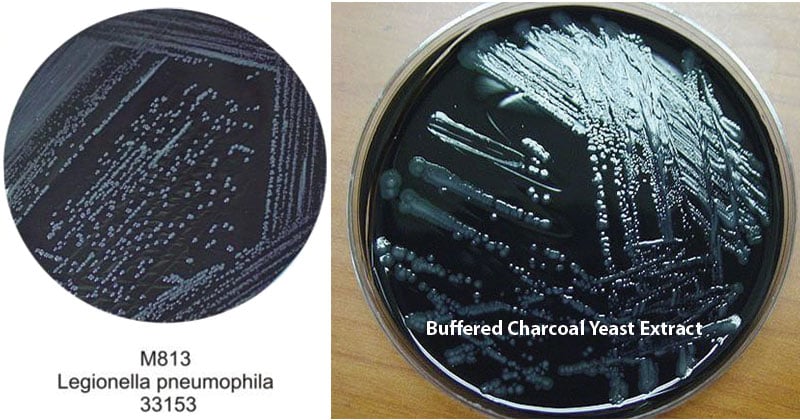Feeley et al in 1978 developed a medium to isolate Legionella species which was later modified by substituting yeast extract for casein hydrolysate and beef extract, and replacing starch with activated charcoal and named it as Charcoal Yeast Extract (CYE) Agar. A further modification was made by Pasculle et al in 1980 by the addition of ACES (N-2-acetamido-2-aminoethane sulfonic acid) buffer in order to maintain the proper pH for optimal growth designated as BCYE for Buffered Charcoal Yeast Extract. In 1981, Edelstein et al further modified the medium by addition of the potassium salt of alpha-ketoglutaric acid which increased the sensitivity of the medium. It is recommended for use in the cultivation and primary isolation of Legionella spp. in water and other samples suspected of harboring the bacteria.

Interesting Science Videos
Composition of BCYE Agar
| Ingredients | Gm/L |
| Yeast Extract | 10.0gm |
| ACES Buffer | 10.0gm |
| Activated Charcoal | 2.0gm |
| Potassium Hydroxide | 2.8gm |
| Alpha-Ketoglutarate | 1.0gm |
| L-Cysteine | 0.4gm |
| Ferric Pyrophosphate | 0.25gm |
| Agar | 12.0gm |
Final pH (at 25°C) 6.9±0.2
Principle of BCYE Agar
Legionella species are non-spore-forming, narrow, gram-negative rods which cause pneumonia (Legionnaires disease) or Pontiac fever. The bacteria do not oxidize or ferment carbohydrates in conventional media or grow on sheep blood agar. Growth is much better and more rapid on Buffered Charcoal Yeast Extract Agar. The BCYE medium comprises the different components that aid in the isolation and growth of the bacterium. Amino acids are the major sources of energy for Legionella. The amino acid L-cystine holds an absolute requirement as it plays a major role in the growth metabolism of Legionella. The amino acid along with ferric pyrophosphate helps for the growth of Legionella. The media contains charcoal, which acts as detoxicant and activated charcoal decomposes hydrogen peroxide, a metabolic product toxic to Legionella species, and may also collect carbon dioxide and modify surface tension. Yeast extract acts as a rich source of vitamins, nitrogen as well as carbon necessary to support growth. ACES buffer maintains optimal pH for growth while L-cystine hydrochloride; ferric pyrophosphate and α-ketoglutarate stimulate the growth of Legionella species by stimulation of oxygen-scavenging enzymes. Agar is the solidifying agent. Selective agents can be added if necessary.
Preparation of BCYE Agar
- Suspend 20 gms in 500 ml distilled water.
- Heat to boiling to dissolve the medium completely.
- Sterilize by autoclaving at 15 lbs pressure (121°C) for 15 minutes and cool to 50°C.
- Aseptically add sterile rehydrated contents of 1 vial each of Legionella Supplement.
- Mix well and pour with constant stirring to ensure that charcoal particles get evenly distributed
Result Interpretation on BCYE Agar
- Legionella pneumophila produces small to large, smooth, colorless to pale, blue-grey, slightly mucoid colonies becoming whiter and more filamentous with age that fluoresces yellow-green under longwave UV light.
- The colony surface is generally smooth with precise edges, but some strains may give a ground glass or “fried egg” appearance when viewed microscopically.
Uses of Buffered Charcoal Yeast Extract (BCYE) Agar
- This medium is to be used for the isolation and presumptive identification of Legionella.
- It is a base medium used for the isolation of Legionella from clinical and environmental samples.
Limitations of Buffered Charcoal Yeast Extract (BCYE) Agar
- It is recommended that biochemical, immunological, molecular, or mass spectrometry testing be performed on colonies from pure culture for complete identification.
- It is also recommended that more than one type of medium is used for isolating Legionella species and that non-selective and selective BCYE Agar plates be inoculated in parallel.
- Due to nutritional variation, some strains may be encountered that grow poorly or fail to grow on this medium.
- The Centers for Disease Control and Prevention (CDC) recommend incubation of environmental samples with 2.5% CO2; however, L. gormanii is the only known species with enhanced growth under this condition.
- Colonies of Legionella that develop on white membrane filters may have a different appearance to those that develop against a black or dark background filter.
- When handling Legionella species, it is important to avoid aerosol formation.
References
- Himedia
- Hardy diagnostic
- Neogen
- Conda lab
- Ronald M. Atlas and James W. Snyder (2014). Handbook of media for clinical and public health microbiology. CRC Press. Taylor & Francis Group, LLC

do you have experience with this organism? will we found them as the only bacterio recovered from this medium, if we inoculate a specimen on it? or will we see numerous species also grow on BYCE?
is it easily can be distinguished from other bacteria colonies?
Quite informative.